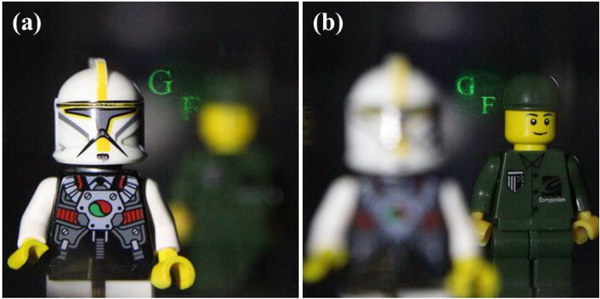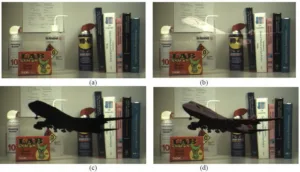I’m not sure this session was named correctly because all five papers in the session involved optical designs for HMDs, not applications of AR/VR.
The first three, Papers 51.1, 51.2 and 51.3 all proposed solutions to the vergence/accommodation problem by using miniature volumetric 3D displays in the HMD to allow the showing of virtual images at the correct distance from the eye so there was no vergence/accommodation problem. Paper 51.1, “True 3D Realization in the See-Through Head-Mounted Display with Complex Amplitude Modulation” was from the Beijing Institute of Technology and made the volumetric virtual image by a technology that is a first cousin to digital holography. 51.2, “Multi-image Plane Display based on Polymer-stabilized Cholesteric Texture” from the University of Central Florida and 51.3, “A Multi-plane Optical See-through Head Mounted Display with Reverse Mode PSLC,” from Shanghai Jiao Tong University, both used miniature multi-plane projection techniques to create the volumetric display.
 Reconstructed volumetric 3D images when focusing at (a) G, 32.5cm, and (b) F, 52.5cm. (Source: Paper 51.1, Beijing Institute of Technology)
Reconstructed volumetric 3D images when focusing at (a) G, 32.5cm, and (b) F, 52.5cm. (Source: Paper 51.1, Beijing Institute of Technology)
In a see-through AR HMD, such as the ones discussed in these three papers, there is, perhaps, more need of accommodation correction. If the AR system puts virtual labels on real objects, especially objects near the viewer, it is very desirable that the viewer’s eye focus on both the real object and the virtual label at the same time. Putting the label at or near optical infinity would mean the user couldn’t read the label while focusing on the nearby objects or see the nearby objects clearly while reading the label.
Paper 51.4, “Near-Eye Display for Vision Correction with Large FOV,” was presented by Yishi Wu also from Shanghai Jiao Tong University and discussed a system that corrected for the user’s glasses’ prescription by shaping the output surface an otherwise relatively conventional holographic see-through AR system. While there is no doubt this would work, it would customize a HMD for a particular user. This might work in the military or industrial worlds but, realistically, it would not be usable in consumer products.
Paper 51.5, “Lightguide with Stair Micromirror Structure for Augmented Reality Glasses,” was presented by Jaeyeol Ryu from Samsung R&D Institute Rus in Moscow. This was a image combiner for a set of see-through AR glasses that is said to have a larger eyebox and wider FOV than other image combiner designs.

